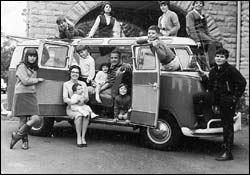NEW YORK (CNN/Money) -
Volkswagen announced this summer that it will introduce a modernized version of the German carmaker's pre-minivan minivan in 2005. The original went into production in the early 1950s but really made a splash in the fab 1960s.
Modernizing is probably a good thing here. As wonderfully appealing as the old Microbus was it had, shall we say, some issues. Even though I was still a child when my family ditched ours, I well remember the Microbus experience. A few e-mails among my older siblings, who actually spent time in the driver's seat while I was kicking around on one of the removable bench seats in the back, filled in some of the memorable details I wasn't able to experience.

My parents bought the Microbus in 1965, about a year after I was born. Being that I was the last of my parents' 11 children, the Sunday drive to church had gotten a little snug in Mom's VW Beetle. (If my father had been the churchgoing type, they probably would have sprung for the Microbus a good bit sooner.)
I mostly remember the sound of the bus's overworked air-cooled engine and the view of tree branches whizzing by those narrow rectangular windows around the roof. Also, there was that special plastic-and-oil interior smell that VW should have trademarked in those years.
| |
 More on CNN/Money Autos
More on CNN/Money Autos
| |
| | |
| | |
|
A few years after we got the bus my older brother, Mark, finally replaced the big, leaky cloth-and-vinyl sunroof with a sheet of Plexiglas and lots of caulking. All the older kids who actually drove it recall the distinctly insufficient engine, the commuter bus-style handling characteristics, and the long stick shift that was like swishing a mop around in a bucket. But, though it limped along at the end with its windshield wipers tied together and its VW nose emblem pocked with rust, it lasted us about a decade. Not a bad showing for a motor vehicle of the time.
To read Part 2, about the new VW Microbus concept vehicle, click here.

|

